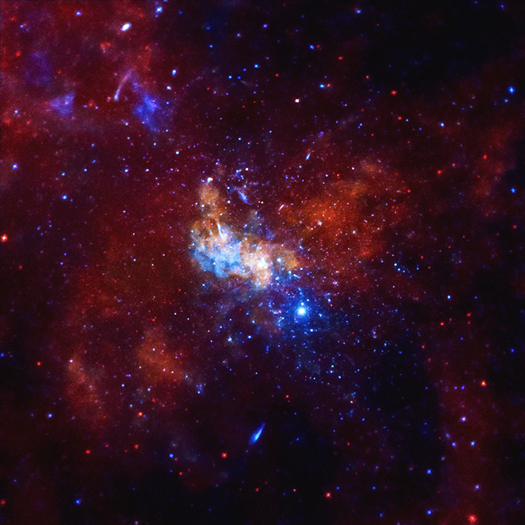NASA X-ray Telescopes Find Black Hole May Be a Neutrino Factory
The supermassive black hole at the center of the Milky Way, seen in this image from NASA's Chandra X-ray Observatory, may be producing mysterious particles called neutrinos, as described in our latest press release. Neutrinos are tiny particles that have virtually no mass and carry no electric charge. Unlike light or charged particles, neutrinos can emerge from deep within their sources and travel across the Universe without being absorbed by intervening matter or, in the case of charged particles, deflected by magnetic fields.
While the Sun produces neutrinos that constantly bombard the Earth, there are also other neutrinos with much higher energies that are only rarely detected. Scientists have proposed that these higher-energy neutrinos are created in the most powerful events in the Universe like galaxy mergers, material falling onto supermassive black holes, and the winds around dense rotating stars called pulsars.
Using three NASA X-ray telescopes, Chandra, Swift, and NuSTAR, scientists have found evidence for one such cosmic source for high-energy neutrinos: the 4-million-solar-mass black hole at the center of our Galaxy called Sagittarius A* (Sgr A*, for short). After comparing the arrival of high-energy neutrinos at the underground facility in Antarctica, called IceCube, with outbursts from Sgr A*, a team of researchers found a correlation. In particular, a high-energy neutrino was detected by IceCube less than three hours after astronomers witnessed the largest flare ever from Sgr A* using Chandra. Several flares from neutrino detections at IceCube also appeared within a few days of flares from the supermassive black hole that were observed with Swift and NuSTAR.
This Chandra image shows the region around Sgr A* in low, medium, and high-energy X-rays that have been colored red, green, and blue respectively. Sgr A* is located within the white area in the center of the image. The blue and orange plumes around that area may be the remains of outbursts from Sgr A* that occurred millions of years ago. The flares that are possibly associated with the IceCube neutrinos involve just the Sgr A* X-ray source.
More information at http://chandra.harvard.edu/photo/2014/sgra/index.html
-Megan Watzke, CXC
Category:
- Log in to post comments

